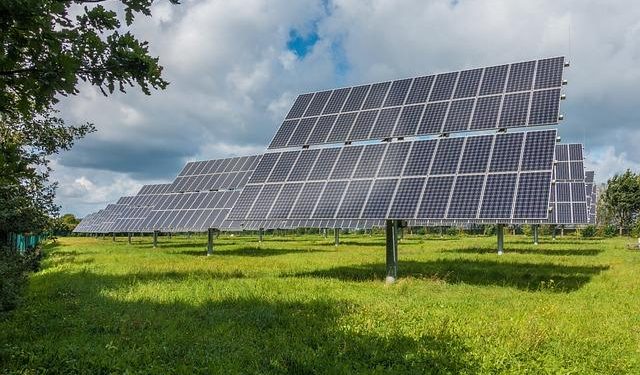In the ever-evolving landscape of renewable energy, the sun has long been hailed as a beacon of hope, offering an abundant and sustainable power source. Yet, as solar panels increasingly dot rooftops and fields worldwide, a pressing question emerges from the shadows: is the very supply chain that fuels this solar revolution inadvertently driving up energy costs? As we embark on this exploration, we peel back the layers of the solar supply chain, examining the intricate web of production, distribution, and innovation. From the silicon mines to the solar farms, we unravel the complexities and challenges that could be influencing the price of harnessing the sun’s rays. Join us on this illuminating journey as we delve into the paradox of solar energy—seeking to understand if the quest for a greener tomorrow comes at a greater cost today.
Challenges in Solar Material Sourcing and Pricing Dynamics
As the solar industry continues to burgeon, the sourcing of essential materials like silicon, cadmium, and rare earth elements has become increasingly complex. The geographical concentration of these resources in certain parts of the world has led to a volatile supply chain, affected by geopolitical tensions, trade policies, and environmental regulations. This creates a precarious balance where the quest for sustainable energy sometimes grapples with the sustainability of the supply chain itself.
Moreover, the pricing dynamics of these materials are subject to the whims of global demand and technological advancements. Fluctuating costs are influenced by several factors, including:
- Technological breakthroughs that can either drive prices down by reducing material requirements or up by increasing demand for cutting-edge materials.
- Environmental policies that may impose additional costs on mining and production processes, affecting overall affordability.
- Market competition where emerging economies might undercut prices, creating a race to the bottom that impacts quality and long-term viability.
These complexities not only impact the financial viability of solar projects but also challenge the industry’s ability to scale sustainably.

Balancing Innovation and Cost in Solar Technology Development
- Innovation: The solar industry is constantly evolving, driven by breakthroughs in photovoltaic technology, battery storage solutions, and efficiency optimization. This relentless pursuit of advancement often necessitates substantial research and development investments. Cutting-edge materials and sophisticated manufacturing processes promise enhanced performance and longer lifespans for solar panels. However, the cost associated with these innovations can sometimes trickle down to the end consumer, potentially increasing the overall price of solar energy solutions.
- Cost Management: On the other side of the spectrum, managing expenses in the solar supply chain is crucial to ensure that solar energy remains an economically viable option. Streamlining production processes, optimizing logistics, and leveraging economies of scale are essential strategies for minimizing costs. Additionally, the integration of digital tools and data analytics can enhance supply chain transparency, allowing for more precise cost control. By finding a harmonious balance between embracing innovation and maintaining affordability, the solar industry can strive towards making renewable energy accessible to a broader audience.

Navigating Regulatory Hurdles in the Solar Industry
The solar industry, despite its promise of cleaner energy and reduced carbon footprints, often finds itself ensnared in a web of regulatory challenges that can inadvertently drive up costs. These hurdles, which vary significantly from region to region, encompass a range of issues from stringent permitting processes to complex tariff structures. Navigating these barriers requires not only compliance but also a strategic approach to align with evolving regulations without stifling innovation.
Key regulatory challenges include:
- Permitting Delays: Lengthy approval processes can stall projects, increasing overheads.
- Tariff Fluctuations: Unpredictable changes in import tariffs can disrupt the supply chain.
- Local Content Requirements: Mandates to source materials locally may lead to higher production costs.
- Interconnection Standards: Varying grid connection standards can complicate project integration.
By addressing these regulatory barriers, the solar industry can work towards a more streamlined supply chain, potentially reducing costs and enhancing the accessibility of solar energy solutions.

Strategic Approaches to Mitigating Solar Supply Chain Costs
Navigating the complexities of the solar supply chain requires innovative strategies to keep costs in check. Diversifying supplier networks can significantly alleviate dependency on a single source, thus reducing vulnerability to geopolitical tensions or local disruptions. By engaging with multiple suppliers across different regions, businesses can leverage competitive pricing and ensure a steady flow of materials.
Another effective approach is investing in local manufacturing capabilities. By shifting production closer to demand centers, companies can cut down on transportation costs and tariffs, while also fostering local economies. Additionally, implementing advanced technologies like blockchain for transparent tracking of materials can enhance accountability and reduce inefficiencies. Businesses should also consider collaborative partnerships to share resources and knowledge, enabling more cost-effective innovations in production processes.
Final Thoughts
As we stand on the cusp of a new era in energy production, the intricate web of the solar supply chain continues to evolve, presenting both challenges and opportunities. While the quest for sustainable energy is more crucial than ever, the dynamics of cost and supply are in constant flux. The question of whether the solar supply chain is making energy more expensive is not one with a simple answer, but rather a complex puzzle that requires careful consideration of economic, environmental, and technological factors. As innovations emerge and markets adjust, the hope is that the sun will not only illuminate our paths but also empower us to find balance and harmony in our pursuit of clean energy. The future of solar power is as bright as the star that fuels it, and its potential impact on our world remains a story still being written.

































